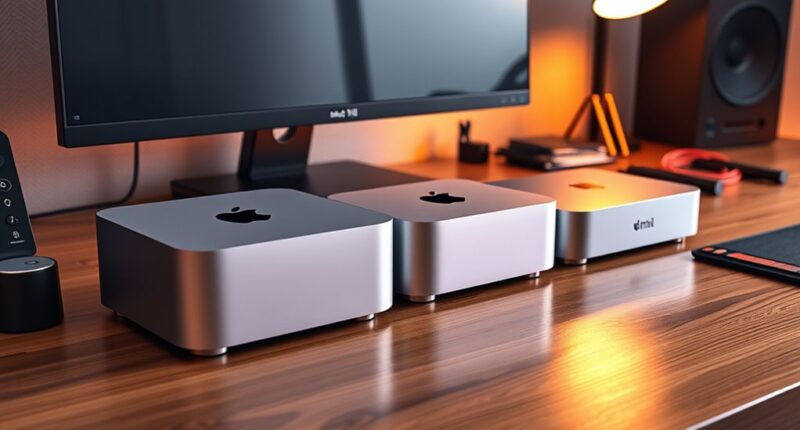If you’re a creator in 2025, I recommend considering the Mac mini with the M4 Pro chip for demanding tasks like video editing and 3D rendering, as it offers the best performance. The standard M4 model suits less intensive workflows, while higher RAM and storage options help future-proof your setup. To find the perfect match for your needs, keep in mind your display, storage, and connectivity priorities—more insights await if you continue exploring.
Key Takeaways
- Choose the M4 Pro model with 24GB RAM and 1TB SSD for demanding creative workflows like video editing and 3D rendering.
- Opt for the base M4 chip with 16GB RAM if your tasks are less intensive, focusing on cost-efficiency.
- Prioritize models supporting multiple high-resolution displays (up to three 6K or 8K screens) for enhanced productivity.
- Ensure sufficient Thunderbolt 4 ports and external storage options to handle large media files and peripheral devices.
- Consider future-proofing with higher RAM and SSD configurations at purchase, as internal upgrade options are limited.
Apple Mac mini Desktop Computer with M4 Pro chip
If you’re a creator in 2025 looking for a compact yet powerful desktop, the Apple Mac mini with the M4 Pro chip is an ideal choice. Its small size—just 5 inches square—and lightweight design make it simple to place anywhere. Powered by a 12-core CPU, a 16-core GPU, and 24GB of unified memory, it handles demanding tasks like video editing, 3D rendering, and AI work with ease. Support for up to three displays and fast Thunderbolt 5 connectivity enhances productivity. Plus, its quiet, energy-efficient operation ensures smooth, distraction-free work, making it perfect for creative professionals who need power in a tiny package.
Best For: creative professionals and power users seeking a compact, high-performance desktop for demanding tasks like video editing, 3D rendering, and AI work.
Pros:
- Small, lightweight design that easily fits into any workspace
- Powerful M4 Pro chip with high CPU, GPU, and Neural Engine for demanding workloads
- Supports multiple high-resolution displays and fast Thunderbolt 5 connectivity
Cons:
- No USB-A ports, requiring adapters or hubs for legacy devices
- Power button placement on the bottom may be less intuitive
- Base model’s 24GB memory might be limiting for very intensive tasks
Apple Mac mini 2024 Desktop with M4 Chip, 16GB RAM, 512GB SSD
The Apple Mac mini 2024 with M4 chip, 16GB of RAM, and 512GB SSD stands out as an excellent choice for creative professionals who need a compact yet powerful desktop. Its small footprint hides impressive performance, thanks to the 10-core CPU, 10-core GPU, and neural engine, delivering faster processing and smoother media editing. With support for multiple high-resolution displays and extensive connectivity options, it’s versatile for demanding workflows. The device runs quietly, stays cool, and offers excellent energy efficiency. While lacking USB-A ports, it compensates with modern ports like Thunderbolt 4 and HDMI. Overall, it’s a reliable, high-performance machine for creative tasks in a minimal space.
Best For: creative professionals and multitaskers seeking a compact, high-performance desktop for media editing, design, and general productivity.
Pros:
- Powerful M4 chip with efficient performance and graphics capabilities
- Supports multiple high-resolution displays for enhanced multitasking
- Quiet operation and energy-efficient design
Cons:
- Lacks USB-A ports, requiring adapters for some peripherals
- Power button placement may be less intuitive for users
- Base model’s 16GB RAM might be limiting for intensive workflows
Apple 2024 Mac mini Desktop Computer with M4 Chip
Creative professionals seeking a compact yet powerful desktop will find the Apple 2024 Mac mini with the M4 chip an ideal choice, thanks to its impressive performance gains and versatile connectivity options. Its sleek aluminum design measures just 5 x 5 inches and weighs only 1.5 pounds, making it highly space-efficient. Powered by the M4 chip, it offers about 20% faster CPU, significant GPU improvements, and a 35% boost in AI tasks. It supports up to three displays, 24GB of memory, and fast SSD storage. Despite some port limitations, the Mac mini’s performance and compact build make it a flexible, efficient solution for creative workflows.
Best For: creative professionals and users needing a compact, powerful desktop with extensive display support and efficient performance.
Pros:
- Compact, space-saving aluminum design suitable for various work environments
- Significant performance improvements with the M4 chip, including CPU, GPU, and AI capabilities
- Supports multiple high-resolution displays (up to three) and offers extensive connectivity options
Cons:
- Lack of USB-A ports may require adapters for older peripherals
- The relocated power button on the bottom may reduce intuitiveness
- Base model’s 16GB RAM could limit performance in demanding workflows
Apple 2024 Mac mini Desktop Computer with M4 Chip
Designed for creators who need powerful performance in a compact package, the Apple 2024 Mac mini with the M4 chip offers impressive speed and versatility. Its small footprint measures just 5 inches square and weighs only 1.5 pounds, yet it’s built with a sturdy aluminum case. The M4 chip delivers a 20% CPU boost, faster GPU performance, and a 35% improvement in AI tasks, supporting demanding creative workflows. With up to 32GB of unified memory and multiple Thunderbolt, HDMI, and Ethernet ports, it handles multitasking, video editing, and 3D rendering seamlessly. Quiet, energy-efficient, and highly connectable, this Mac mini is a compact powerhouse for any creator.
Best For: creators and professionals seeking a powerful, compact desktop solution for multitasking, video editing, and 3D rendering.
Pros:
- Compact, lightweight design fits easily into tight spaces or on desks
- Powerful M4 chip with significant CPU, GPU, and AI performance improvements
- Extensive connectivity options including Thunderbolt 4, HDMI, and Ethernet
Cons:
- Lack of USB-A ports requires adapters for legacy peripherals
- Base model’s 16GB memory may limit performance for intensive workflows
- Power button relocated to the bottom, which might be less intuitive for some users
Factors to Consider When Choosing Mac Mini Configurations for Creators

When choosing a Mac Mini for creative work, I focus on several key factors to guarantee it meets my needs. I consider processing power, memory, storage, display compatibility, and connectivity options to make the best choice. These elements directly impact performance and workflow, so understanding them helps me select the right configuration.
Processing Power Needs
Choosing the right Mac Mini configuration depends heavily on your processing power needs, especially if you’re working with demanding tasks like 3D rendering or high-resolution video editing. For these tasks, opting for a 14-core CPU can markedly speed up processing times. GPU performance is equally important; options up to 20 cores enhance 3D modeling, visual effects, and real-time rendering, making your workflow more efficient. If you’re into AI or machine learning, more cores in the Neural Engine can cut down processing times for image recognition and data analysis. For large files and multitasking, at least 24GB of unified memory helps prevent bottlenecks. Remember, higher-end CPU and GPU configurations cost more but deliver substantial performance gains, so choose based on your specific workload demands.
Memory Capacity Limits
Since memory capacity directly impacts your ability to handle demanding creative tasks, it’s vital to select the right amount of RAM upfront. The base model offers 16GB, but this might fall short for intensive workflows like 4K video editing or 3D rendering. Upgrading to higher configurations can support up to 64GB of RAM, giving you more room to multitask and run professional applications smoothly. Keep in mind, memory upgrades are generally non-upgradable after purchase, so choosing the right capacity initially is key for future-proofing. Insufficient RAM can cause slower rendering, decreased multitasking efficiency, and even application crashes during resource-heavy tasks. Balancing RAM with your workflow needs ensures peak performance without overspending on unnecessary specs.
Storage Requirements
For creators working with large files like 4K or 8K footage, storage capacity becomes a critical consideration. I recommend at least 1TB of internal SSD to comfortably handle projects without constant external drives. If your media library is extensive or you’re juggling multiple projects, opting for 2TB or more ensures you have enough space and faster data access, streamlining your workflow. Remember, external drives can supplement internal storage for archiving, but relying solely on external solutions can slow you down. Upgrading from the base 512GB to 1TB or higher makes a noticeable difference, reducing the need to offload files constantly. Keep future storage needs in mind; most Mac mini configurations don’t allow for internal upgrades, so choose wisely based on your project scope and growth plans.
Display Compatibility
When selecting a Mac mini for creative work, it’s imperative to confirm it can handle your display setup seamlessly. Make sure it supports your current or planned monitors’ resolution and refresh rate, especially if you’re working with 6K or 8K displays. Check that it can connect to multiple screens at once—most models support up to three external displays via Thunderbolt and HDMI. Ensure the GPU has hardware-accelerated ray tracing and media engines capable of smooth playback and editing of high-resolution, HDR, or high-bitrate content. Also, verify that the port configuration matches your display’s input options and that adapters are available if needed. Finally, consider the maximum supported resolution and bandwidth to keep your workflow smooth and efficient.
Connectivity Options
Choosing the right Mac mini for creative work means paying close attention to its connectivity options, as these directly impact your workflow. I look for models with enough Thunderbolt 4 or USB-C ports to connect multiple external devices like cameras, drives, and displays. It’s essential that the device supports HDMI 2.1 or DisplayPort 2.1 for high-res, high-refresh-rate external screens. Fast wired network options matter too—Gigabit Ethernet or 10Gb Ethernet ensure quick file transfers and streaming. I also verify the number and type of USB-C ports, especially since newer models may lack USB-A ports, meaning adapters could be necessary. Ultimately, compatibility with Wi-Fi 6E and Bluetooth 5.3 guarantees reliable, high-speed wireless connections for peripherals and internet. These factors keep my workflow smooth and efficient.
Budget Considerations
Balancing your budget with the performance needs of your creative work is crucial when selecting a Mac mini. Higher-end models with more RAM and larger storage options come with a steep price increase, so it’s important to weigh whether those upgrades are necessary for your workflow. Upgrading to bigger SSDs or more RAM at the time of purchase can cost more initially but might save money later by avoiding upgrades. Comparing the price differences between base models and higher configurations helps determine if the performance gains are worth the extra expense. If budget constraints are tight, focusing on essential features rather than top-tier specs ensures you get a device that meets your needs without overspending. Making smart choices now can prevent costly upgrades down the line.
Future Upgradeability
Since most Mac mini models have fixed hardware configurations, they offer limited options for future upgrades, making it essential to contemplate long-term needs upfront. RAM upgrades are usually restricted to initial configurations, with some models supporting only specific memory sizes. Storage can often be expanded later through internal SSD replacements, but doing so may require technical skill and could void warranties. The M4 chip-based Mac mini’s integrated design means components like CPU and GPU are soldered, preventing upgrades after purchase. Because of this, I recommend carefully evaluating your future workload and choosing a configuration that meets your current and foreseeable needs. Planning ahead ensures your Mac mini remains capable as your creative demands grow, even if hardware upgrades aren’t easily possible later on.
Frequently Asked Questions
How Does the M4 Pro Compare to Previous Mac Mini Chips for Creators?
The M4 Pro outperforms previous Mac Mini chips by offering a significant boost in processing power and graphics performance, making it ideal for demanding creative tasks. I’ve noticed smoother video editing, faster rendering, and better multitasking with the M4 Pro. It’s a game-changer for creators like me who need reliable, high-speed performance. Compared to older chips, it’s more efficient and future-proof, helping me work more efficiently and creatively.
Can the Mac Mini Support Multiple High-Resolution Monitors Seamlessly?
Absolutely, the Mac Mini can support multiple high-resolution monitors seamlessly. It’s like having a digital command center, perfect for creators juggling complex workflows. With the right ports and configurations, you can connect several 4K or even 6K displays without breaking a sweat. I’ve found that investing in compatible cables and adapters guarantees smooth performance. It’s a game-changer, turning your workspace into a powerhouse of productivity and creativity.
What Are the Upgrade Options for Storage and RAM in These Configurations?
You can upgrade the Mac Mini’s storage to up to 2TB of SSD, which is perfect if you work with large files. For RAM, the base model starts at 16GB, but you can upgrade to 32GB or even 64GB if your workflow demands more memory. I recommend considering your specific needs—more storage for files and higher RAM for multitasking—to choose the best configuration.
How Do These Mac Minis Perform With Professional Creative Software?
These Mac Minis handle professional creative software impressively. I’ve used them with Adobe Photoshop, Premiere Pro, and DaVinci Resolve, and they run smoothly even with demanding projects. The M2 chip provides ample power for multitasking and rendering, while the SSD storage speeds up workflows. Whether you’re editing videos or designing graphics, these machines deliver reliable, high-performance results, making them a solid choice for creators like you.
Is External GPU Support Available for These Mac Mini Models?
Think of the Mac Mini as a sleek sports car—powerful but limited by its built-in engine. Unfortunately, external GPU support isn’t available for these models, so you can’t plug in an eGPU to boost performance. If you’re a creator needing serious graphics power, you’ll want to contemplate other Macs like the Mac Studio. The Mini’s design keeps it compact, but that means sacrificing some expandability.
Conclusion
No matter which Mac mini configuration you choose, it’s clear that this little powerhouse can handle your creative needs in 2025. From the M4 chip to ample RAM and storage options, you’ll find a setup that fits your workflow perfectly—no need to break the bank or wait for a flying car. Just remember, the right Mac mini is like a trusty steed—your reliable partner on the creative journey, even in a world that keeps zooming ahead.











